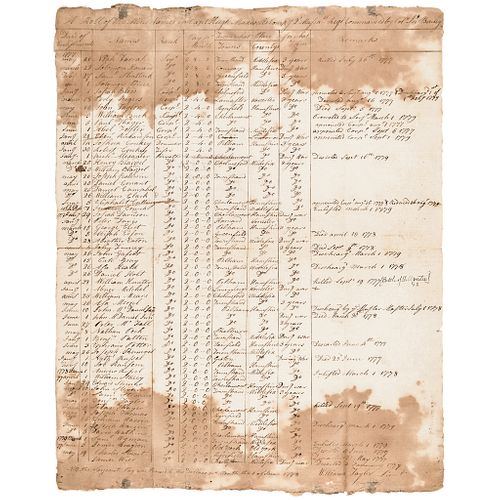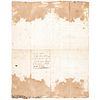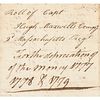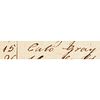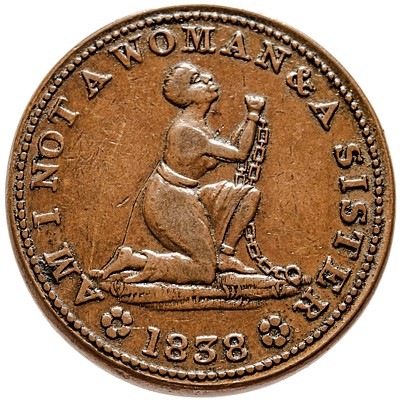BLACK Soldier, CATO GRAY Listed VALLEY FORGE Period Continental Army Muster Roll
Lot 12
Categories
Estimate:
$14,000 - $16,000
Absentee vs Live bid
Two ways to bid:
- Leave a max absentee bid and the platform will bid on your behalf up to your maximum bid during the live auction.
- Bid live during the auction and your bids will be submitted real-time to the auctioneer.
Bid Increments
| Price | Bid Increment |
|---|---|
| $0 | $10 |
| $200 | $20 |
| $300 | $25 |
| $500 | $50 |
| $1,000 | $100 |
| $2,000 | $200 |
| $3,000 | $250 |
| $5,000 | $500 |
| $10,000 | $1,000 |
| $20,000 | $2,000 |
| $30,000 | $2,500 |
| $50,000 | $5,000 |
| $100,000 | $10,000 |
| $200,000 | $20,000 |
| $300,000 | $25,000 |
| $500,000 | $50,000 |
About Auction
By Early American History Auctions
Feb 27, 2021
Set Reminder
2021-02-27 12:00:00
2021-02-27 12:00:00
America/New_York
Bidsquare
Bidsquare : Black History & Slavery, Historic Autographs, Colonial America & Weapons
https://www.bidsquare.com/auctions/early-american-history-auctions/black-history-slavery-historic-autographs-colonial-america-weapons-6434
318 Lots of Rare, Historic Autographs, Americana, Civil War Era, George Washington, Abraham Lincoln, Slavery & Black History, Revolutionary War Era, Colonial America, Federal Period, War of 1812, Colonial Currency, Historic Early American Guns & more... Early American History Auctions auctions@earlyamerican.com
318 Lots of Rare, Historic Autographs, Americana, Civil War Era, George Washington, Abraham Lincoln, Slavery & Black History, Revolutionary War Era, Colonial America, Federal Period, War of 1812, Colonial Currency, Historic Early American Guns & more... Early American History Auctions auctions@earlyamerican.com
- Lot Description
Black History
African American Black Soldier at Valley Forge: "CATO GRAY" "...For the depreciation of the Continental Money 1777 1778 & 1779" Inclusive of Active Service at Camp Valley Forge Exceptional Revolutionary War Muster Roll for Captain Hugh Maxwell's Company of Continental Army Soldiers of the 2nd Massachusetts Regiment
c. 1779 Highly Important Revolutionary War Period Manuscript Document Signed, "William Taylor Lieut," Listing, "CATO GRAY" (a documented African-American Black Soldier), as enlisting on May 15th of 1777 (Including during Camp Valley Forge), Headed across its top margin: "A Roll of the Men's Names in Capt. Hugh Maxwell's Compy 2d Massa.ts Regt Commanded by Col. Jno. Bailey," Fine.
This Manuscript Document is a Muster Roll listing Sixty individual Continental Army Soldiers plus the signature at its conclusion of "William Taylor Lieut." Handwritten and fully readable on a single large sheet of handmade period laid paper, measuring 16.5" x 13.25". Portions at top and bottom with deep humidity toning, though not seriously affecting its legibility. There is a boldly penned Docket on the blank reverse side panel which reads, in full: "Roll of Capt Hugh Maxwells Compy 2d Massachusetts Regt - For the depreciation of the Money 1777 1778 & 1779." Various nicely separated, lined Columns include specific information on each soldier including: "Date of Enlistments - Names - Rank - Pay per Month - From what Place: Towns / Countys (sic) - for what Term (of enlistment) - Remarks (the latter adding specific notes regarding such events as; Killed from battle, Died, Discharged, Inlisted (sic), or other reasons ... Desertions, Appointments, field Promotions, etc.. A short added notation at bottom left reads: "VB the Sergeants Pay was Raised to ten Dollars per Month the 1 of June 1778."
This Muster Roll lists the names of 11 Officers and 49 Enlisted men including a "Drummer" and a "Fifer" of Captain Hugh Maxwell's company in the 2nd Massachusetts Regiment. They had joined Washington's main army at Valley Forge after serving at Saratoga in 1777. While most of the soldiers listed were enlisted for a three-year term, about a quarter had enlisted for the duration of the war. Unit members listed likely included early veterans, those listed here mostly including dates (possible re-enlistments) from 1777 thru 1779. Although not specifically stating the name Valley Forge on this document, wet weather and poor sanitation would conspire to kill nearly 2,500 men that horrible Winter when they served at Camp Valley Forge. At least one of the soldiers listed was African-American, "Cato Gray" of the Town of "Pelham" in "Hampshire" County, (Massachusetts). Cato Gray was later discharged from his service 3 years later, on May 16th,1780.
Hugh Maxwell was a Massachusetts Minute-Man who joined Prescott's Company after hearing about the Battle of Lexington. Maxwell fought at the Battle of Bunker Hill where he was injured when a musket ball passed through his right shoulder. Later, he was present at the Siege of Boston, Defense of Canada, Lake Champlain, and the Battles of Trenton, Princeton, Saratoga, plus the Defense of Philadelphia, Philadelphia-Monmouth.
The 2nd Massachusetts Regiment Capt. Hugh Maxwell's company of the 2nd Massachusetts entered Camp Valley Forge as part of, and remained in, de Kalb's Division in December 1777 and left in June 1778. They entered Valley Forge with 459 men assigned, with 297 fit for duty and left Valley Forge with 392 assigned, and only 226 fit for duty. This remarkable Document Muster Roll also reviews and details the scourge of "depreciation of the Continental Money." Valley Forge period related muster rolls appear on the market quite infrequently and are highly prized by Revolutionary War specialists. This original, fully authentic handwritten Document covers the specific timeframe and period of service at Valley Forge. In addition, it specifically lists "the depreciation of the Money 1777 1778 & 1779" on the docket and most importantly also lists documented African-American Black Soldier, CATO GRAY shown enlisting on May 15th of 1777.
"African Americans at Valley Forge" From The National Park Service:
The majority of the African-Americans who served in the Continental Army at Valley Forge, were in combat units, they manned positions in the outer defense lines and were on foraging parties. These soldiers also helped in the construction of the huts and fortifications that were here in the encampment. They also performed specialized duties in many fields such as medical orderlies, musicians, waiters, wagoners, and armorers.
African-Americans and white soldiers received the same pay, wore the same uniforms, and shared the winter hardships of short rations and being sheltered in cold huts. There were no whole African-American regiments that served at Valley Forge. Most of the African-American soldiers served in regiments from Rhode Island, Connecticut, and Massachusetts mixed in with other ethnic groups.
As the army dwindled -- due to the many hardships at Valley Forge -- the army was in constant need of reorganization and new troops. General James Mitchel Varnum and others believed that recruiting more African-Americans was needed to win the war and save the army. In January of 1778, Varnum convinced the Commander-in-Chief George Washington, that the states needed to foot the bill to purchase the freedom of slaves and train them into the Continental Army.
In February of 1778, Rhode Island became the first state to purchase the freedom for slaves. The first slaves to enlist in the army were Cuff Greene, and Dick and Jack Champlin. Rhode Island paid 120 for their freedom. In June of 1778, General Varnum left the Valley Forge Encampment to train these troops. Between 130 and 300 African-Americans joined the Continental Army before the law allowing their enlistment was repealed on June 10th 1778.
Some of the other African-Americans that were here during the encampment included Shadrack Battles, a 32-year-old "free man of color" who enlisted in the Tenth Virginia Regiment in December 1779, and Windsor Fry, another free black man who served with the First Rhode Island Regiment. Salem Poor of Massachusetts, who purchased his freedom, came to Valley Forge after distinguished service at Bunker Hill and Saratoga. One of these slaves serving as substitutes for their masters was Samual Surphen in the New Jersey Brigade.
Citations & Further Information See:
Becton, Joseph. "Black Soldiers At Valley Forge." 1985.
Fleming, Thomas J. Washington's Secret War: The Hidden History of Valley Forge. New York: Smithsonian /Collins, 2005.
Greene, Lorenzo. "Some Observations On The Black Regiment Of Rhode Island In The American Revolution." 1952.
Quarles, Benjamin. The Negro in the American Revolution. University of North Carolina Press, 1961.
Stephenson, Michael. Patriot Battles: How the War of Independence Was Fought. New York: HarperCollins, 2007.
__________
Early in 1776 confidence in the Continental money began to waver. The bills were sometimes refused. A general uneasiness began to prevail in the public mind concerning them; and Committees of Safety and other authorities in the several Colonies were constrained to adopt measures for sustaining them. Patriotic men came forward and offered to redeem them at par, and exchanges of one thousand dollars in silver were made for the same sum in Continental Paper.
But these examples were not potent enough to allay the public distrust, and the Continental Congress was compelled to take the matter in hand. On the 11th of January, 1776, after intimating in a preamble that the Tories, or the adherents of the Crown, were endeavoring to depreciate the currency, the Congress resolved:
"That if any person shall hereafter be so lost to all virtue and regard for his country as to refuse to receive said bills in payment, or obstruct and discourage the currency or circulation thereof, and shall be duly convicted by the committee of the city, county, or district, or in case of appeal from their decision, by the Assembly, Convention, Council, or Committee of Safety of the Colony where he shall reside, such person shall be decreed, published, such treated as an enemy of his country, and precluded from all trade or intercourse with the inhabitants of these colonies."
And when, at near the close of the year, immediately after the battle of Trenton, Washington was invested by the Congress with the powers of Military Dictator for six months, one specification of those powers authorized him "to arrest and confine persons who refuse to take the Continental Currency," and to return to the States of which they were citizens, their names, together with those of the witnesses.
At the close of 1776 the Congress had issued bills to the amount of $25,510,000. From that time, when they were at five per cent discount, they rapidly depreciated, in spite of all efforts in their favor; and twelve months afterward $325 in paper was equivalent to only $100 in specie.
Our Auction Contents:
Black History & Slavery: (Lots 1 - 63)
Abraham Lincoln Related: (Lots 64 - 74)
Historic Autographs: (Lots 75 - 235)
Colonial America: (Lots 236 - 261)
Revolutionary War: (Lots 262 - 304)
George Washington Related: (Lots 305 - 306)
Early American Guns & Weapons: (Lots 307 - 318) - Shipping Info
-
Early American provides in-house worldwide shipping. Please contact us directly if you have questions about your specific shipping requirements.
-
- Buyer's Premium



 EUR
EUR CAD
CAD AUD
AUD GBP
GBP MXN
MXN HKD
HKD CNY
CNY MYR
MYR SEK
SEK SGD
SGD CHF
CHF THB
THB